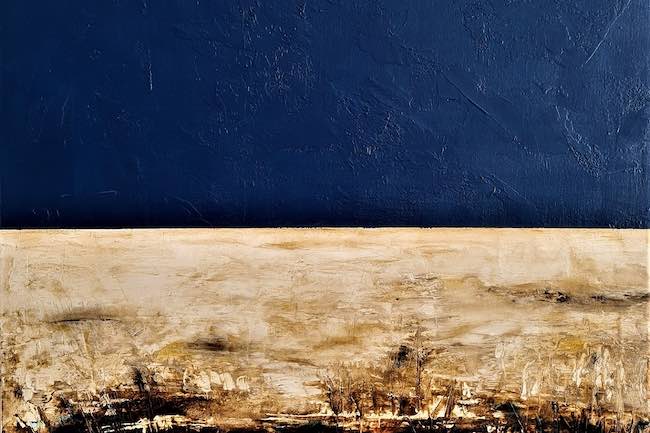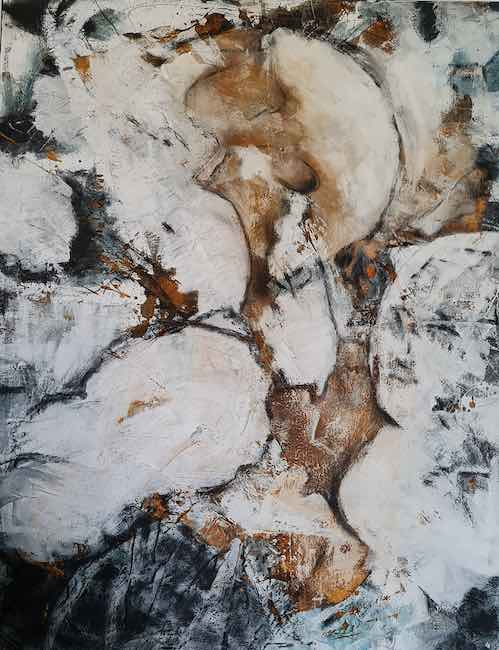Nel momento in cui l’uomo moderno, e in particolar modo l’artista con la sensibilità che lo contraddistingue, avverte l’esigenza di andare oltre la superficie che sembra essere divenuta l’apparato prioritario del vivere contemporaneo, si verifica la tendenza a un distacco dalla realtà oggettiva, l’emergente necessità di andare oltre quella coltre invisibile che sembra essere uno scudo nei confronti dell’approfondimento indispensabile per comprendere, piuttosto che soltanto osservare, se stessi e il mondo intorno. La scelta di compiere questo tipo di percorso optando per l’indefinitezza di un’immagine che altrimenti richiederebbe la conformazione alla tendenza da cui si cerca di allontanarsi, sembra pertanto quasi obbligata, imprescindibile per intraprendere quel cammino di connessione tra sensibilità percettiva e desiderio di oltrepassare l’osservato. L’artista di origini italiane ma di fatto cittadina del mondo e attualmente residente in Austria Antonella Quacchia, sceglie la libertà stilistica dell’Espressionismo Astratto per compiere il suo personale viaggio di ricerca ma al tempo stesso di raccolta di tutti quei frammenti di conoscenza, di emozioni e di ricordi che solo in un secondo tempo possono concretizzarsi sulla tela.
L’elaborazione delle linee guida dell’Espressionismo Astratto, movimento fondato da Jackson Pollock, Franz Kline, Willem de Koonig, Mark Tobey e Mark Rothko, fu la conseguenza del rifiuto dell’aderenza alla realtà osservata compiuta dai movimenti più razionali e distaccati dall’emozione come il De Stijl, lo Spazialismo, l’Astrattismo Geometrico, e la tendenza dell’Astrattismo Lirico di Vassily Kandinsky, ritenuto il fondatore dell’Arte Astratta, a mantenere invece il contatto con il sentire soggettivo, con l’armonia tra quanto espresso sulla tela e quanto percepito a livello sensoriale dall’autore dell’opera. Ciò che divenne essenziale a seguito delle due guerre mondiali in cui la bellezza aveva perduto il suo senso più classico e il distacco della razionalità non era più sufficiente ad affermare la supremazia dell’arte su un mondo esterno che si era appena sgretolato lasciando profonde ferite nella sensibilità degli artisti; dunque il gesto plastico di poneva come rifugio, come luogo in cui dare sfogo a tutta la gamma emozionale che non poteva più restare nascosta all’interno dell’interiorità ma che aveva bisogno di allontanarsi dalla contingenza per potersi esprimere al meglio. La prerogativa principale dell’Espressionismo Astratto era pertanto quella di lasciare agli artisti aderenti la libertà di scegliere il linguaggio più affine alla sensibilità, all’approccio introspettivo con cui ciascuno di loro si poneva in connessione con le profondità con cui filtravano il vissuto. L’Action Painting e il Dripping erano tecniche più immediate, irruente quasi, decisamente impulsive in cui il gesto esecutivo si fondeva con l’impeto creativo di un’urgenza di esprimere e liberare le sensazioni più intense, e che si traducevano sulla tela con spruzzi, macchie, gocciolature di colore, tanto quanto invece il Color Field appariva il mezzo in virtù del quale personalità più equilibrate e meditative trovavano la dimensione migliore per raccontare se stessi e il proprio universo interiore sulla tela. Mark Rothko, Barnett Newman, vicino anche al Minimalismo per la sua tendenza alla monocromia, Helen Frankenthaler diedero la propria interpretazione della pittura a macchie di colore esprimendo in tal modo la propria personalità. L’artista di origini italiane Antonella Quacchia approda all’Espressionismo Astratto per assecondare la sua esigenza di manifestare su tela in maniera spontanea e senza regole esecutive se non le proprie, tutto il bagaglio culturale, emotivo, di apertura all’altro che nel corso della sua vita costantemente in viaggio ha accumulato, assorbito come una spugna intuendo quanto tutte le persone incontrate, tutti i popoli conosciuti in maniera approfondita per le lunghe permanenze in paesi stranieri, avrebbero contato nel momento in cui avrebbe deciso di riprendere in mano a tempo pieno i pennelli.
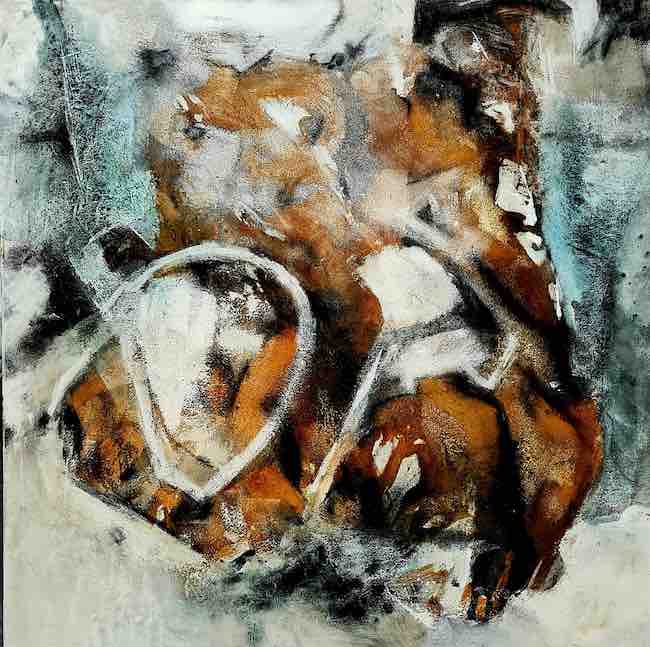
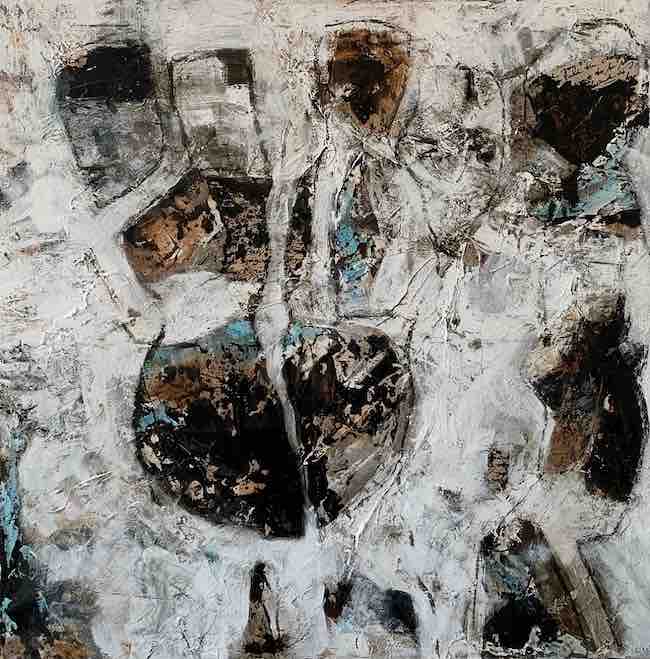
Il suo punto di osservazione della realtà con cui è entrata in contatto è stato sempre morbido, inclusivo, come se fosse consapevole che la molteplicità delle esperienze e delle sensazioni vissute avessero contribuito a migliorare la sua naturale attitudine all’ascolto, al trovare il lato positivo e piacevole anche in quelle circostanze in cui apparentemente di piacevole non c’era nulla; la saggezza acquisita esattamente in virtù della poliedricità di modi di vivere e di porsi nei confronti della quotidianità e dell’esistenza, si diffonde nelle sue tele attraverso un alternarsi tra luci e ombre, tra tonalità terrose e polverose e le macchie di luce, interpretate con il bianco, che subentrano e diventano dominanti per condurre l’osservatore a comprendere l’importanza di mantenere il contatto con la fiducia che tutto possa modificarsi, volgere al meglio, proprio come accade di fatto, malgrado i timori e le ansie.
L’opera Dream in white (Sogno in bianco) rappresenta la dimensione del sogno inteso non tanto come qualcosa di irraggiungibile, utopico, bensì come un auspicio, la speranza di assistere a quella trasformazione verso la luminosità in una quotidianità anonima e spesso deludente; Antonella Quacchia sembra voler esortare l’osservatore a prendere in mano le redini della sua esistenza per tendere verso quel possibilismo, quell’opzione spesso non considerata in grado di modificare il panorama presente e futuro. Ecco perché il titolo evoca il sogno, per ricordare che anche ciò che sembra inarrivabile è invece molto più vicino e possibile di quanto si immagini.
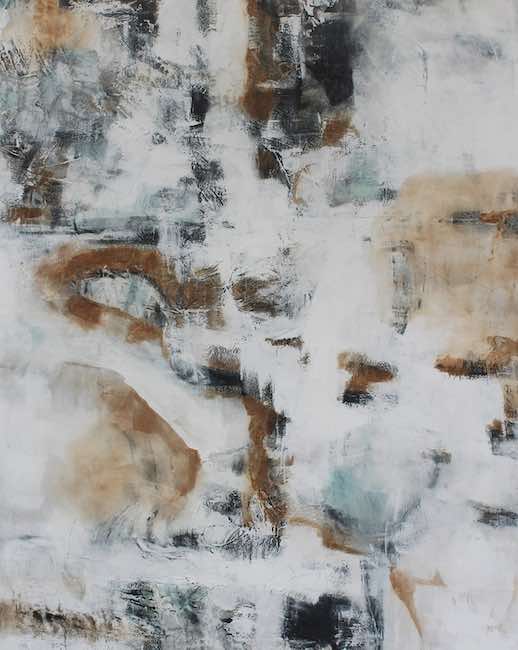
In The way home (La via verso casa) allo stesso modo, la luce riempie l’opera, quel bianco dominante racconta non solo della via del ritorno bensì anche di tutto il bagaglio di esperienze, di avventure, di passaggi che hanno costituito il viaggio precedente, che sia durato un giorno o tutta la vita non importa perché al ritorno nessuno sarà mai lo stesso della partenza; dunque quel rientrare a casa da un lato costituisce un sollievo ma dall’altro azionerà quel meccanismo per il quale comincerà a emergere la nostalgia, il ricordo di un vissuto che, se assaporato e interpretato nella giusta maniera, ha costituito un nuovo insegnamento, un modo per osservare se stessi da un punto di vista differente. Ma l’attitudine verso il Color Field emerge in maniera ancor più forte in quelle tele che intitola con i nomi dei colori dominanti che appaiono quasi come panorami di praterie, di pianure sterminate dove nella parte più bassa pone la terra, intesa come il senso pratico, razionale, concreto del vivere, mentre nella metà superiore lascia prevalere la tonalità cromatica netta, appena sfumata ma fondamentalmente intensa a cui intitola la tela e che costituisce l’eco della sensazione, del ricordo o del desiderio inconfessato che avvolgono il lato meno logico che costituisce la parte maggiore, l’essenza più vera di ciascun individuo.
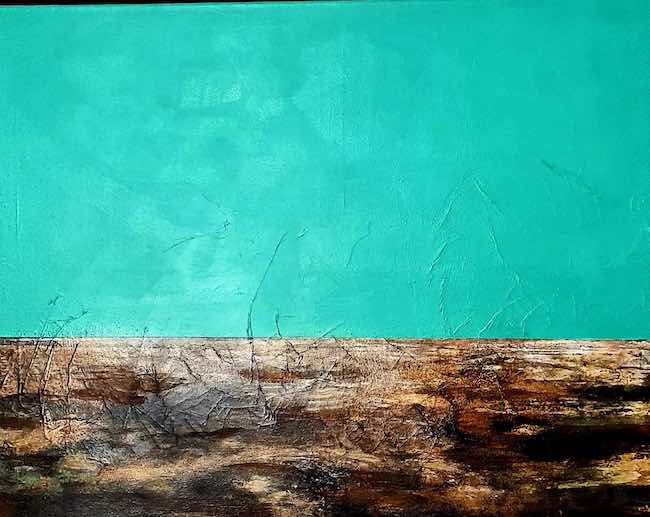
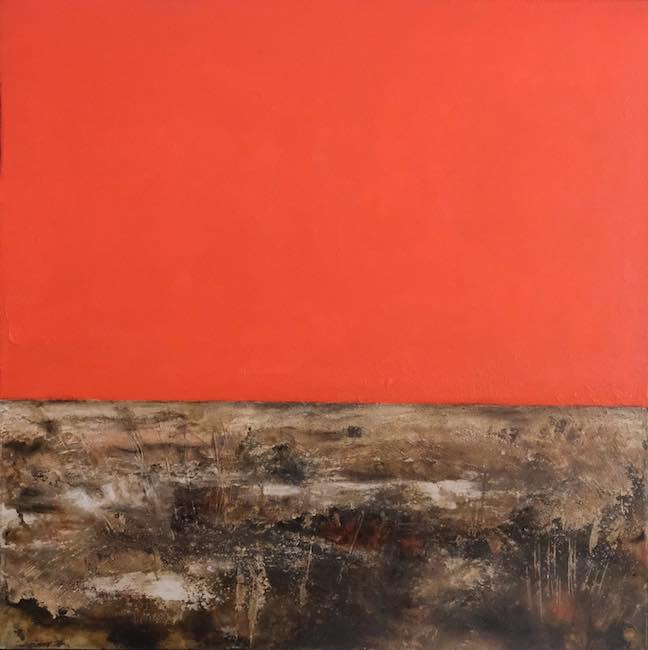
Tourquoise (Turchese) evoca dunque un cielo estivo, una necessità di dimenticare i problemi, rappresentati dal colore marrone, beige, terra, e di innalzarsi verso una dimensione più piacevole, e molto più leggera, quella dell’aria, dell’azzurro che infonde una sensazione di fiducia nei confronti delle energie sottili che ruotano intorno senza essere ascoltate; e ancora Red (Rosso) sembra invece una celebrazione della passione, di quella capacità di combattere per ciò in cui si crede davvero senza il timore di perdere, scegliendo comunque di non tirarsi indietro perché in fondo vale sempre la pena tentare, insistere e far valere ciò a cui si tiene. Anche in quest’opera emerge l’approccio alla vita di Antonella Quacchia, sempre positivo nonostante le increspature, metafore degli ostacoli, che compaiono sulle sue opere, perché in fondo malgrado le opposizioni, le vicissitudini, le contrarietà, l’essere umano si sente vivo ed evolve solo quando supera se stesso, quando si mette in discussione e sceglie di rischiare.
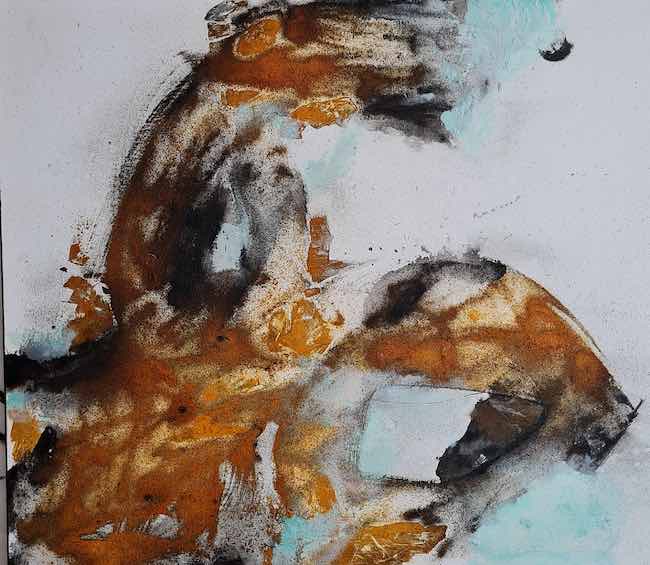
Antonella Quacchia torna alla pittura, e si dedica esclusivamente a essa dopo avervi rinunciato a lungo a causa di scelte professionali e di vita, nel 2017 anno a partire dal quale ha cominciato a partecipare a molte mostre collettive internazionali e a mostre personali a Vienna, dove vive e lavora; le sue opere sono attualmente inserite in importanti cataloghi internazionali di arte. La mostra di Venezia, presso Palazzo Pisani-Revedin, in calendario dal 9 al 15 agosto 2022, è la prima personale in Italia.
ANTONELLA QUACCHIA-CONTATTI
Email: antonella.quacchia@gmail.com
Sito web: https://www.anton4art.com
Facebook: https://www.facebook.com/antonella.quacchia
https://www.facebook.com/itsanton4art
Instagram: https://www.instagram.com/anton4art/
Antonella Quacchia’s gaze towards the essential, between Colour field and listening to surrounding suggestions
At a time when modern man, and in particular the artist with the sensitivity that distinguishes him, feels the need to go beyond the surface that seems to have become the priority apparatus of contemporary living, there is a tendency towards a detachment from objective reality, the emerging need to go beyond that invisible blanket that seems to be a shield against the in-depth study indispensable to understand, rather than just observe, oneself and the world around. The decision to take this type of path, opting for the indefiniteness of an image that would otherwise require conforming to the trend from which one seeks to move away, therefore seems almost obligatory, unavoidable in order to embark on that path of connection between perceptive sensitivity and the desire to go beyond the observed. The artist, of Italian origin but in fact a citizen of the world and currently resident in Austria, Antonella Quacchia, chooses the stylistic freedom of Abstract Expressionism to undertake her personal journey of research but at the same time of collecting all those fragments of knowledge, emotions and memories that only later can materialise on canvas.
The elaboration of the guidelines of Abstract Expressionism, a movement founded by Jackson Pollock, Franz Kline, Willem de Koonig, Mark Tobey and Mark Rothko, was the consequence of the rejection of the adherence to observed reality made by the more rational movements detached from emotion such as De Stijl, Spatialism, Geometric Abstractionism, and the tendency of the Lyrical Abstractionism of Vassily Kandinsky, considered to be the founder of Abstract Art, to instead maintain contact with subjective feeling, with the harmony between what is expressed on the canvas and what is perceived on a sensory level by the author of the artwork. This became essential following the two world wars in which beauty had lost its most classical sense and the detachment of rationality was no longer sufficient to assert the supremacy of art over an external world that had just crumbled, leaving deep wounds in the artists’ sensibilities; thus the plastic gesture posed itself as a refuge, as a place in which to give vent to the entire emotional range that could no longer remain hidden within the interiority but needed to distance itself from contingency in order to express itself at its best. The main prerogative of Abstract Expressionism was therefore to leave the adhering artists free to choose the language most akin to their sensitivity, to the introspective approach with which each of them connected with the depths through which they filtered their experience.
Action Painting and Dripping were more immediate techniques, impetuous almost, decidedly impulsive, in which the executive gesture merged with the creative impetus of an urgency to express and release the most intense sensations, and which were translated on canvas with splashes, spots, drips of colour, just as much as the Colour Field appeared to be the means by virtue of which more balanced and meditative personalities found the best dimension to tell about themselves and their inner universe on canvas. Mark Rothko, Barnett Newman, who was also close to Minimalism due to his tendency towards monochrome, and Helen Frankenthaler gave their own interpretation of colour field painting, thus expressing their own personalities. The Italian-born artist Antonella Quacchia turned to Abstract Expressionism to satisfy her need to express on canvas in a spontaneous manner and without any executive rules other than her own, all the cultural and emotional baggage and openness to the other that she has accumulated during her life spent constantly travelling, absorbed like a sponge, realising how much all the people she has met, all the peoples she has come to know in depth during her long stays in foreign countries, would have mattered when she decided to pick up her paintbrushes full-time.
Her point of observation of the reality she came into contact with was always soft, inclusive, as if she was aware that the multiplicity of experiences and sensations she had lived through had contributed to improve her natural aptitude for listening, for finding the positive and pleasant side even in those circumstances in which there was apparently nothing pleasant; the wisdom acquired precisely by virtue of the multifaceted ways of living and posing in relation to everyday life and existence, spreads through her canvases through an alternation of light and shadow, between earthy, dusty tones and the patches of light, interpreted with white, which take over and become dominant to lead the observer to understand the importance of keeping in touch with the trust that everything can change, turn for the better, just as it actually does, despite fears and anxieties. The painting Dream in white represents the dimension of the dream understood not so much as something unattainable, utopian, but rather as a wish, the hope of witnessing that transformation towards brightness in an anonymous and often disappointing everyday life; Antonella Quacchia seems to want to exhort the observer to take the reins of his existence into his own hands in order to tend towards that possibilism, that option often not considered capable of modifying the present and future panorama. This is why the title evokes the dream, to remind us that even what seems unattainable is instead much closer and possible than we imagine. In The way home in the same way, light fills the artwork, that dominant white tells not only of the way back but also of all the baggage of experiences, adventures, passages that made up the previous journey, whether it lasted a day or a lifetime does not matter because on the return journey no one will ever be the same as the departure; whether it lasts a day or a lifetime is not important because on the return journey no one will ever be the same as when he left; so that returning home on the one hand is a relief, but on the other it will trigger that mechanism by which nostalgia will begin to emerge, the memory of an experience which, if savoured and interpreted in the right way, has constituted a new teaching, a way of observing oneself from a different point of view. But her aptitude for the colour field emerges even more strongly in those canvases she entitles with the names of the dominant colours that appear almost like panoramas of prairies, of endless plains where in the lower half she places the earth, intended as the practical, rational, concrete sense of living, while in the upper half she lets the sharp, barely shaded but fundamentally intense chromatic tone prevail, to which she entitles the canvas and which constitutes the echo of the sensation, of the memory or of the unconfessed desire that envelops the less logical side which constitutes the greater part, the truest essence of each individual.
Tourquoise therefore evokes a summer sky, a need to forget problems, represented by the colour brown, beige, earth, and to rise towards a more pleasant, and much lighter, dimension, that of air, of blue, which instils a feeling of trust in the subtle energies that revolve around without being heard; and again Red seems to be a celebration of passion, of that ability to fight for what you really believe in without fear of losing, choosing not to back down because, after all, it is always worth trying, insisting and asserting what you care about. Also in this artworks emerges Antonella Quacchia’s approach to life, always positive despite the ripples, metaphors for the obstacles, that appear on her artworks, because after all, despite the oppositions, vicissitudes, and contrarieties, the human being feels alive and evolves only when he overcomes himself, when he questions himself and chooses to take risks. Antonella Quacchia returned to painting, and devoted herself exclusively to it after having renounced it for a long time due to professional and life choices, in 2017, the year from which she began to participate in many international group exhibitions and solo shows in Vienna, where she lives and works; her paintings are currently included in important international art catalogues. The exhibition in Venice, at Palazzo Pisani-Revedin, scheduled from 9 to 15 of August 2022, is her first solo show in Italy.


